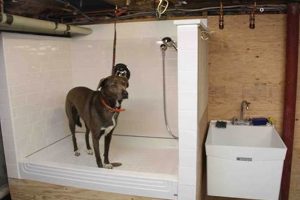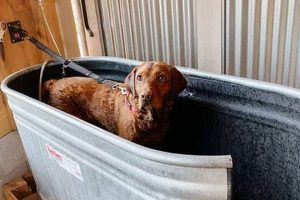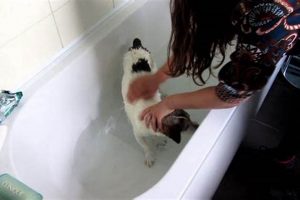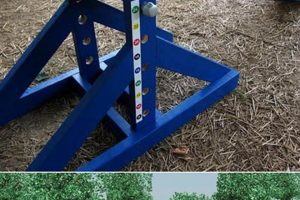A homemade canine resting place, often crafted from lumber, provides a personalized alternative to commercially available pet furniture. These constructions range from simple platforms to elaborate miniature versions of human beds and offer a customizable solution for pet owners seeking a specific aesthetic or size.
Creating individualized pet beds offers numerous advantages. It allows for size and design customization tailored to the specific animal and home environment. Repurposing existing materials contributes to sustainability, and the project fosters a deeper connection between owner and pet through the act of creation. Historical examples show similar approaches to animal care, demonstrating a long-standing desire for customized comfort for companion animals.
The following sections will explore material selection, construction techniques, design considerations, and finishing options for building durable and aesthetically pleasing pet beds.
Tips for Crafting a Durable Canine Resting Place
Successful construction of a long-lasting canine resting place hinges on careful planning and execution. The following tips outline essential considerations for achieving optimal results.
Tip 1: Prioritize Material Selection: Opt for hardwoods like oak, maple, or birch for superior durability and resistance to chewing. Softwoods, while more affordable, may require protective sealant to prevent damage from moisture and potential splintering.
Tip 2: Ensure Accurate Measurements: Precisely measure the intended occupant to determine appropriate bed dimensions. Add ample space for comfortable stretching and repositioning. Consider adding a raised edge or bolster for enhanced security and comfort.
Tip 3: Employ Secure Joinery Techniques: Implement strong joinery methods such as mortise and tenon, dovetail, or pocket hole screws for robust construction. Weak joints compromise structural integrity and reduce the lifespan of the bed.
Tip 4: Apply Pet-Safe Finishes: Utilize non-toxic, pet-safe paints, stains, and sealants to avoid potential health risks. Ensure complete drying and ventilation to eliminate harmful fumes before introducing the canine occupant.
Tip 5: Incorporate Ventilation: Design the structure to promote adequate airflow beneath the sleeping surface. This reduces moisture buildup and inhibits the growth of mold and mildew, contributing to a healthier environment.
Tip 6: Consider Removable Components: Incorporate features like removable side panels or a replaceable base for easier cleaning and maintenance. This extends the bed’s lifespan and maintains hygiene.
Tip 7: Integrate Chew-Resistant Edges: Reinforce exposed edges with metal strips or durable plastic edging to deter chewing and prevent damage to the wood structure.
Adherence to these recommendations contributes significantly to the longevity, safety, and overall quality of a handcrafted canine resting place.
The following sections will explore common design patterns and customization options.
1. Design Customization
Design customization, in the context of homemade canine resting places, allows for precise tailoring of the bed’s dimensions, style, and functionality to meet the unique needs of both the pet and the owner’s aesthetic preferences. The cause-and-effect relationship is direct: a desire for a specific size, shape, or visual appearance necessitates a custom design approach. This is paramount as commercially available beds often fail to adequately accommodate larger breeds, dogs with specific physical limitations, or owners seeking a particular dcor integration.
The importance of design customization lies in its ability to address these limitations. For instance, a Great Dane requires significantly more sleeping space than a Chihuahua; a custom design ensures adequate comfort and support. A senior dog with arthritis may benefit from a lower bed profile and supportive orthopedic cushioning, features often absent in standard models. Furthermore, the ability to select specific wood types, finishes, and decorative elements enables seamless integration with existing home furnishings. Examples range from crafting a rustic-style bed from reclaimed barn wood to building a modern, minimalist platform bed with sleek lines and a customized color palette.
A proper understanding of design customizations possibilities ensures a more practical and pleasing outcome. This understanding ensures not only optimal comfort and safety for the animal occupant but also enhanced aesthetic appeal within the home environment. Overlooking this element can result in a final product that fails to meet the intended purpose or detracts from the overall visual harmony of the living space. The challenge lies in balancing design ambition with practical construction limitations, thus highlighting the importance of thoughtful planning and execution.
2. Material Durability
Material durability represents a critical factor in the construction of a homemade canine resting place. The longevity and safety of the bed directly correlate with the properties of the chosen materials, necessitating careful consideration of factors such as wood type, resistance to moisture, and potential for splintering.
- Wood Species Selection
The choice of wood species significantly impacts the structural integrity and lifespan of the bed. Hardwoods, such as oak, maple, and cherry, offer superior density and resistance to wear and tear compared to softwoods like pine or fir. This translates to a bed that can withstand the rigors of daily use, including scratching, chewing, and general wear. While softwoods may offer a more cost-effective alternative, they require more frequent repair or replacement and may pose a safety risk if splinters occur.
- Moisture Resistance
Exposure to moisture, whether from spills, drool, or humid environments, can compromise the integrity of the bed. Untreated wood is susceptible to rot, mildew, and warping, which can weaken the structure and create an unhealthy environment for the pet. Utilizing naturally water-resistant wood species, such as cedar or redwood, or applying a waterproof sealant provides a protective barrier against moisture penetration, extending the life of the bed and preventing the growth of harmful microorganisms.
- Splintering Potential
Certain wood types, particularly softwoods, are prone to splintering, which poses a significant hazard to the canine occupant. Splinters can cause injury if ingested or embedded in the skin. Careful selection of wood species and thorough sanding of all surfaces are essential steps in mitigating this risk. Applying a durable, non-toxic finish further reduces the likelihood of splintering and creates a smooth, safe surface for the animal.
- Resistance to Canine Behavior
Canine behavior, such as chewing and scratching, can severely compromise material durability. Selecting robust materials capable of withstanding such activity is crucial. Hardwoods and metal reinforcements are often incorporated to protect vulnerable areas. Proper training to dissuade destructive behaviors is recommended to preserve the integrity of the handcrafted dog bed.
In conclusion, material durability is paramount in ensuring the creation of a safe, long-lasting, and aesthetically pleasing canine resting place. Careful consideration of wood species, moisture resistance, and splintering potential, coupled with appropriate protective measures, will result in a bed that provides years of comfortable and reliable service.
3. Joint Strength
The integrity of a homemade canine resting place hinges significantly on the strength of its joinery. Joint strength, referring to the capacity of connections between wooden components to withstand stress and strain, directly influences the structural stability and longevity of the bed. Inadequate joint strength leads to premature failure, rendering the bed unsafe and unusable. Strong joinery, conversely, ensures the bed can withstand the weight of the animal, resist movement, and endure normal wear and tear over an extended period.
The selection of appropriate joinery techniques depends on several factors, including the type of wood used, the overall design of the bed, and the desired level of durability. Simple butt joints, relying solely on fasteners like screws or nails, are generally insufficient for load-bearing connections. More robust methods, such as mortise and tenon joints, dovetail joints, or the use of pocket hole screws with glue, provide significantly greater resistance to separation and shear forces. For example, a large-breed dog putting its weight on the corner of the bed frame exerts considerable stress on the joints; weak joints will eventually loosen or break, whereas stronger joints will maintain their integrity. The application of high-quality wood glue, combined with mechanical fasteners, further enhances joint strength.
Ultimately, prioritizing joint strength in the construction process translates to a more durable, safe, and cost-effective outcome. Failure to do so risks creating a structure that is prone to collapse or damage, potentially injuring the animal. Therefore, a thorough understanding of joinery principles and the selection of appropriate techniques are essential for anyone undertaking the construction of a homemade canine resting place. Attention to detail in the cutting, fitting, and fastening of joints will contribute significantly to the overall quality and lifespan of the bed.
4. Finish Safety
Finish safety constitutes a paramount consideration in the construction of a do-it-yourself wooden dog bed. The coatings applied to the wood surface directly impact the health and well-being of the animal occupant, necessitating meticulous attention to the selection and application of non-toxic and durable finishes.
- Non-Toxic Components
The composition of wood finishes frequently includes volatile organic compounds (VOCs) and other potentially harmful chemicals. Ingestion or prolonged exposure to these substances can lead to adverse health effects in canines, ranging from skin irritation and respiratory issues to more severe systemic complications. The use of finishes certified as low-VOC or VOC-free minimizes these risks, ensuring a safer environment for the animal. Examples include water-based paints and natural oil finishes formulated without harmful additives.
- Durability and Resistance to Chewing
Canines often exhibit chewing behavior, particularly when presented with novel objects or experiencing anxiety. Finishes lacking sufficient durability can be easily damaged or removed, potentially leading to ingestion of the coating material. Selecting finishes with enhanced resistance to abrasion and saliva is crucial. Polyurethane-based coatings, when fully cured, offer a relatively durable barrier. However, their safety must be verified before application, ensuring they meet low-VOC standards.
- Proper Application and Curing
The safety of a finish is not solely determined by its chemical composition; proper application and curing are equally important. Inadequate ventilation during application can result in prolonged off-gassing of harmful vapors, posing a respiratory hazard. Similarly, incomplete curing can leave residual chemicals on the surface, increasing the risk of ingestion. Adhering to the manufacturer’s instructions regarding application techniques, drying times, and ventilation requirements is essential for ensuring the finish achieves its intended level of safety.
- Maintenance and Longevity
The chosen finish should not only be safe initially but also maintain its integrity over time. Frequent cleaning and exposure to canine activity can degrade some finishes, leading to the release of potentially harmful particles or the creation of rough surfaces that can harbor bacteria. Regular inspection and maintenance, including reapplication of the finish as needed, contribute to the continued safety and hygiene of the canine resting place.
The careful selection and application of safe and durable finishes are indispensable components in the creation of a homemade wooden dog bed. Prioritizing the health and well-being of the animal occupant necessitates a thorough understanding of finish composition, application techniques, and long-term maintenance requirements.
5. Size Appropriateness
Size appropriateness constitutes a foundational element in the construction of a do-it-yourself wooden dog bed. The dimensions of the bed directly influence the comfort, support, and overall well-being of the animal occupant. Failure to adequately accommodate the canine’s physical needs can lead to discomfort, restricted movement, and potentially, musculoskeletal issues. The relationship is causative: insufficient size results in compromised comfort and potential health consequences. Conversely, excessive size may not provide the desired sense of security and enclosure, particularly for smaller breeds.
The importance of size appropriateness stems from its direct impact on the canine’s ability to rest and recuperate effectively. A dog should be able to lie down fully extended, without any part of its body hanging over the edge of the bed. It should also have ample space to turn around and reposition itself comfortably. For example, a German Shepherd requires a significantly larger sleeping area than a Dachshund. Ignoring these size discrepancies when designing a wooden dog bed can result in the animal refusing to use the bed or experiencing discomfort that disrupts its sleep patterns. Understanding the practical significance of size appropriateness allows for the creation of a bed that not only provides physical support but also fosters a sense of security and well-being, thereby promoting restful sleep and overall health.
Accurate measurement of the dog in its relaxed, sleeping posture is crucial for determining appropriate bed dimensions. Consideration should be given to growth potential for younger animals. Furthermore, the addition of bolsters or raised edges may influence the necessary interior dimensions. The challenge lies in balancing adequate space with a design that is proportionate to the overall environment. Properly addressing size appropriateness in the construction of a homemade wooden dog bed ensures a comfortable and supportive resting place, contributing significantly to the animal’s quality of life.
Frequently Asked Questions
This section addresses common inquiries and misconceptions pertaining to the construction and utilization of homemade wooden resting places for canines. The information provided aims to clarify key aspects of the process, ensuring informed decision-making and optimal outcomes.
Question 1: What wood types are most suitable for construction, considering both durability and canine safety?
Hardwoods such as oak, maple, and birch offer superior durability and resistance to canine chewing. Softwoods like pine require thorough sealing and may pose a splintering risk. All materials should be non-toxic and free of chemical treatments.
Question 2: How can the risk of splinters be minimized when working with wood?
Thorough sanding of all wooden surfaces, followed by the application of a durable, non-toxic sealant, significantly reduces the likelihood of splintering. Regular inspection and maintenance are also recommended.
Question 3: What are the recommended methods for joining wooden components to ensure structural integrity?
Mortise and tenon joints, dovetail joints, and pocket hole screws combined with wood glue offer robust and reliable connections. Simple butt joints are generally insufficient for load-bearing applications.
Question 4: How should the dimensions of the bed be determined to ensure adequate comfort and support for the canine occupant?
Measure the dog in its relaxed, sleeping posture, ensuring ample space for stretching and repositioning. Add several inches to these measurements to determine the appropriate interior dimensions of the bed.
Question 5: What types of finishes are safe for use on a canine resting place, and how should they be applied?
Water-based, low-VOC paints and natural oil finishes are generally considered safe. Adhere strictly to the manufacturer’s instructions regarding application, drying times, and ventilation to minimize potential hazards.
Question 6: How can the homemade bed be effectively cleaned and maintained to prevent the buildup of bacteria and odors?
Regular vacuuming and wiping down with a damp cloth are recommended. Removable and washable bedding components facilitate more thorough cleaning. Ensure the wood is properly sealed to prevent moisture absorption.
Proper attention to material selection, construction techniques, and finishing processes is paramount to the safety and longevity of a homemade wooden resting place for canines. Diligence in these areas ensures a comfortable and secure environment for the animal occupant.
The next section will discuss popular design patterns for inspiration.
Conclusion
This exploration of the construction of a do-it-yourself wooden dog bed has emphasized crucial considerations, ranging from material selection and joint strength to finish safety and size appropriateness. The successful creation of such a structure demands careful planning and execution to ensure both durability and the well-being of the animal occupant. Adherence to established best practices in woodworking is essential for achieving a safe and aesthetically pleasing outcome.
The effort invested in crafting a suitable resting place for a canine companion reflects a commitment to responsible pet ownership and fosters a stronger bond between owner and animal. The principles outlined herein serve as a foundation for informed decision-making and contribute to the creation of a functional and enduring element within the domestic environment. The thoughtful application of these concepts guarantees an optimal outcome.







